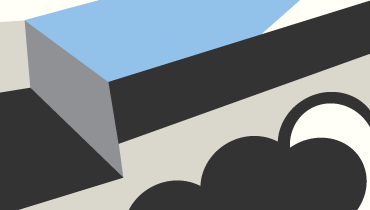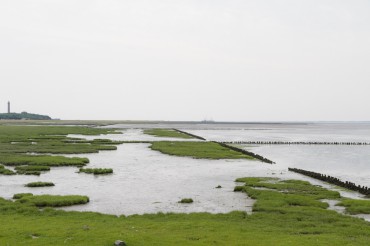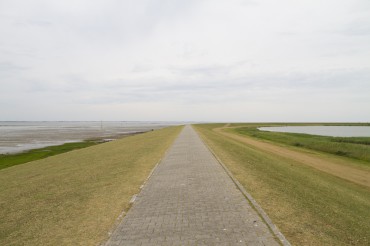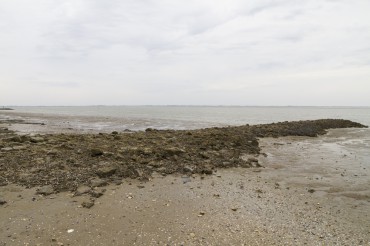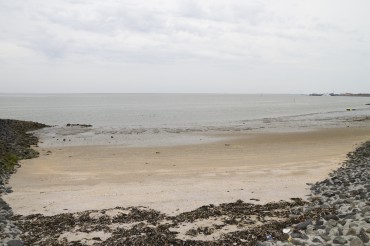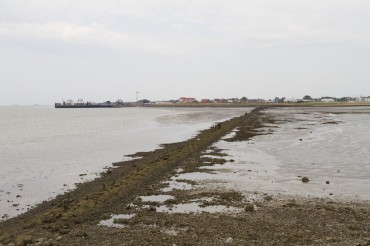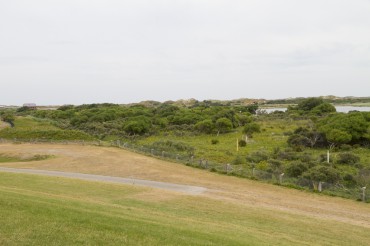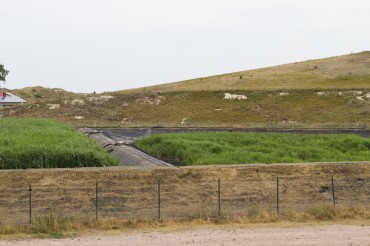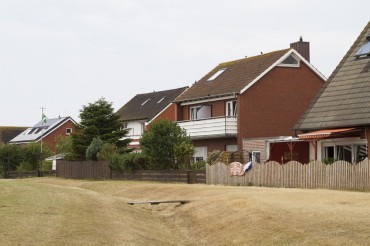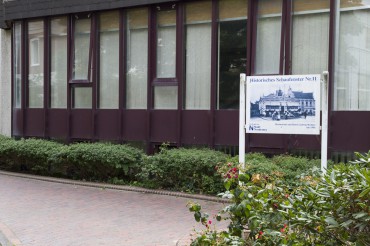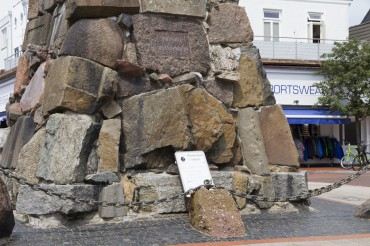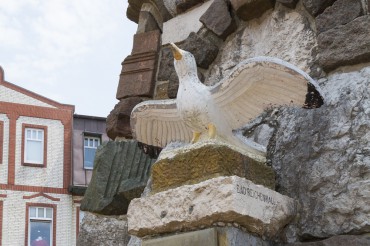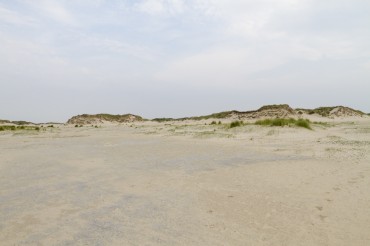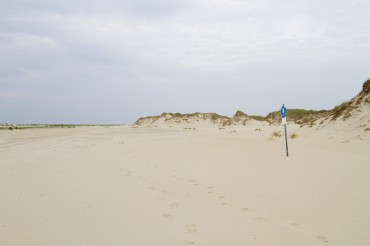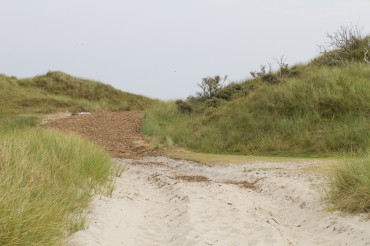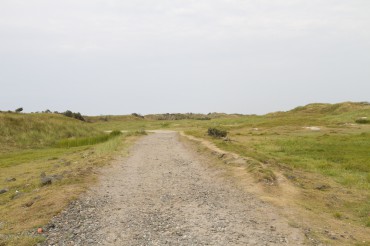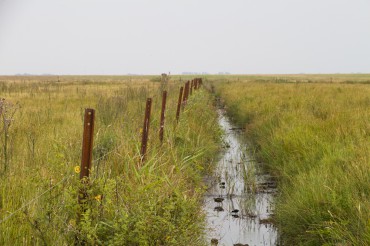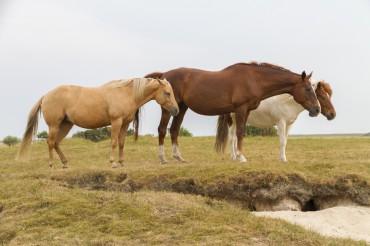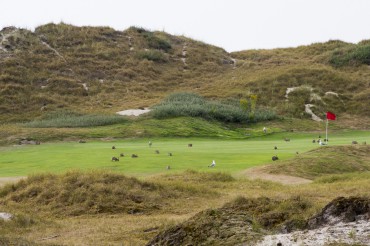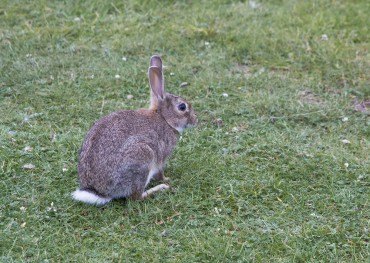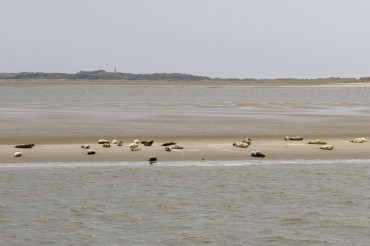The campsite was on the southern side of the island facing the mainland. The terrain was flat, and as it neared the Wadden Sea, it became marshy. A fence prevented us from getting close to the water. I assumed the site itself had once been salt marsh, as it was between the two areas of reclaimed land of the island: the Südstrandpolder which became dry land between 1940 to 41; and the slightly older Grohdepolder, drained from 1926 to 28.
The Südstrandpolder jutted out from the island next to the caravan area. We set out early and followed the route around its perimeter and into town.
The Sunday weather was cooler and the sky had reverted to being cloudy with occasional sunny spells. The pathway led over an embankment, next to the type of grassy verge that Germans refer to as a Grünstrand or “green beach”. Happily we had the path mostly to ourselves, disturbed only by the odd leisure cyclist.
The polder was markedly flatter than the dune landscape immediately to its north. We passed a series of ponds marked on the map as the “Sielteich”, and I noted that most of the inside of this human-made peninsula was wetland and didn’t seem to be accessible. A few greylag geese had wandered on to the path and remained quite calm as we walked past.
I wondered why an area seemingly for wildlife conservation would have been constructed during a time of war, and particularly during the year when Norderney was being bombed. I later found out that the polder was drained in order to build a military seaplane base. This was not completed by the time the war finished and the plans were abandoned. The new land was allowed to overgrow until the late 1980s, when piles of sand were removed making the polder at least partially aquatic again. The newly created wetlands were then officially designated a nature reserve.
At the southernmost point, we walked over the revetments and on to the sand flats. Despite the cloudy conditions, the mainland was visible on the horizon. Reaching the west side, we passed the breakwater over the fishing harbour and walked again north in the direction of the town.
We passed a fenced-off wooded area and a hill, which I recognised as the former garbage dump. Around its edges was what appeared to be a plantation of marram grass. I had heard that dune grass was grown intensively on Norderney and used to stabilise dunes not only here but on neighbouring islands such as Langeoog.
From here, we went into a housing estate – fairly typical for a provincial town but seemingly used mostly for short-term holiday rentals, or for retirees. We walked past the water tower and into the town, looking for something to drink as Tom was thirsty.
While we were there, we happened upon the rather odd memorial to Kaiser Wilhelm I made of stones from 75 towns of the German empire. I would have much rather visited the Heinrich Heine memorial, but it was already early afternoon, so we pressed on.
We took a bus to the nudist beach, which seemed to be about as far as the roads take you. The expanse of sand here was so wide that we could tread our way past without disturbing the few people lying in wait of a glimpse of sun through the clouds. As we got further away from the Strandkörbe, it began to feel wilder. We were alone apart from dogs insistently running up to us, their owners some distance away.
We had a picnic of crisps and water, and Alessandra performed an exercise routine on the sand. We went in the sea for a while and I tried to film underwater, making use of the waterproof feature of my phone. The sea, however, was too opaque and the results were just a fuzz of grey and green. After about 45 minutes, I was adamant that we were wasting time and packed our stuff. We walked a way further along the beach and turned back into the dunes. Here we entered an immense desert of sand, crossing which seemed to take forever.
Eventually the sand gave way to bark and gravel, and we could find our way along the designated pathway of the island’s “quiet zone”, heading back in the direction of the campsite.
Using the lighthouse as a landmark, we got to where the road started. We walked beside the Grohdepolder – where horses and Galloway cattle are reared – with its neat ditches and drains. The flat open fields were not unlike the Frisian mainland.
The lighthouse was built in the 1870s and remains the tallest structure on the island. Today it is used as a visitor attraction providing panoramic views. We walked past the golf hotel, which although abandoned-looking was still in business and represented the planet Pluto on the trail organised by the Norderney Astronomical Association.
One of the defining features of Norderney is the proliferation of rabbits, which were rampant wherever we looked. I guessed that these must have caused problems with the maintenance of the dunes.
More irritating for me was the excessive number of cyclists who always asserted their right of way on the footpaths. One of them angrily shouted at me for walking in the centre of the path and not on the right side as if I were a car on a road. Despite spending the past eight years in Germany, its customs feel ever more alien to me.
Back at the campsite. I managed to photograph a couple of rabbits, before we settled into our tents. Overnight showers turned into a heavy downpour that lasted for most of the following morning. The cheap tent we had brought for Alessandra soaked through, and she spent much of the night sat under the canopy of the toilet block. By the time we caught the return ferry, the skies had cleared but not enough for us to sit on deck. We had a simple lunch on the boat, picked up the car in Norden and a few hours later, we dropped Alessandra at the airport.
